|

#108-19415-56th. Ave.
Surrey, B.C. - Langley, B.C.
V3S 6K2
Ph: (604) 530-9160
Fax: (604) 530-9168



 |
|

Our shop is
equipped with the best technology money can buy. We
currently have 2 John Bean 3D alignment machines; the latest in
alignment advancement. ICBC approved technology allows our
technicians to complete wheel alignments with precision,
accuracy with no margin for error.
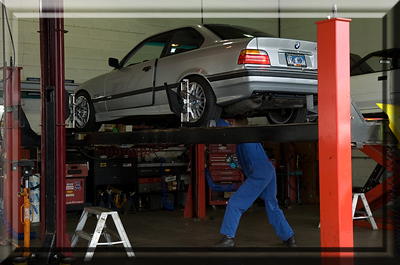
 We
cater to all cars, light & medium trucks, SUV's, and motor homes
but are also able to align performance and "tricked" out rides
as well. Renowned throughout the lower mainland for
alignments on lowered vehicles, lifted 4X4's, race cars / drag
cars, we do it all with highly trained technicians and, more
importantly, pride. We
cater to all cars, light & medium trucks, SUV's, and motor homes
but are also able to align performance and "tricked" out rides
as well. Renowned throughout the lower mainland for
alignments on lowered vehicles, lifted 4X4's, race cars / drag
cars, we do it all with highly trained technicians and, more
importantly, pride.
Whether it's as
simple as a basic 4-wheel alignment or as in depth assign its most basic form, a wheel alignment
consists of adjusting the angles of the wheels so that they are
perpendicular to the ground and parallel to each other. The
purpose of these adjustments is maximum tire life and a vehicle
that tracks straight and true when driving along a straight and
level road.
 |
If you know anything about wheel alignment,
you've probably heard the terms
Camber, Caster and
Toe-in. Down below is a description of each of
these alignment angles and how they affect handling, vehicle
performance, steering and tire wear. |
Facts each driver should know about wheel alignments:
-
At Dale's, a proper wheel
alignment always starts and ends with a road test.
-
Our technicians will inspect the
front end and steering linkage for wear before performing the
alignment.
-
The tires should all be in good
shape with even wear patterns. If you have a tire with excessive
camber wear, for instance, and you correct the alignment problem
that caused that wear, the tire will now be making only partial
contact with the road. Tire wear will continue.
-

-
-
Pulling problems are not always
related to wheel alignment. Problems with tires (especially
unequal air pressure and radial ply tire pulls) and loose
suspension parts can also be responsible.
It is up to our
wheel alignment technicians to determine the cause and inform
you of what is required to successfully perform the alignment.
Alignment
Angles
Camber
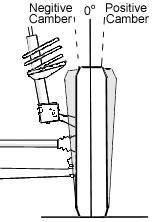 Camber
is the angle of the wheel, measured in degrees, when viewed from
the front of the vehicle. If the top of the wheel is leaning out
from the center of the car, then the camber is positive ,if it's
leaning in, then the camber is negative. If the camber is out of
adjustment, it will cause tire wear on one side of the tire's
tread. If the camber is too far negative, for instance, then the
tire will wear on the inside of the tread. Camber
is the angle of the wheel, measured in degrees, when viewed from
the front of the vehicle. If the top of the wheel is leaning out
from the center of the car, then the camber is positive ,if it's
leaning in, then the camber is negative. If the camber is out of
adjustment, it will cause tire wear on one side of the tire's
tread. If the camber is too far negative, for instance, then the
tire will wear on the inside of the tread.
Camber Wear Pattern
If the camber is different from side to side
it can cause a pulling problem. The vehicle will pull to the
side with the more positive camber. On many front-wheel-drive
vehicles, camber is not adjustable. If the camber is out on
these cars, it indicates that something is worn or bent,
possibly from an accident and must be repaired or replaced.
Caster
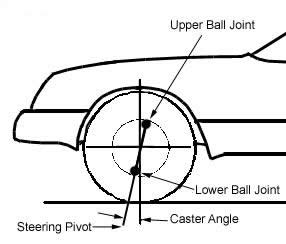 |
When you turn
the steering wheel, the front wheels respond by turning on a
pivot attached to the suspension system. Caster is the angle
of this steering pivot, measured in degrees, when viewed
from the side of the vehicle. |
If the top of the pivot is
leaning toward the rear of the car, then the caster is positive,
if it is leaning toward the front, it is negative. If the caster
is out of adjustment, it can cause problems in straight line
tracking.
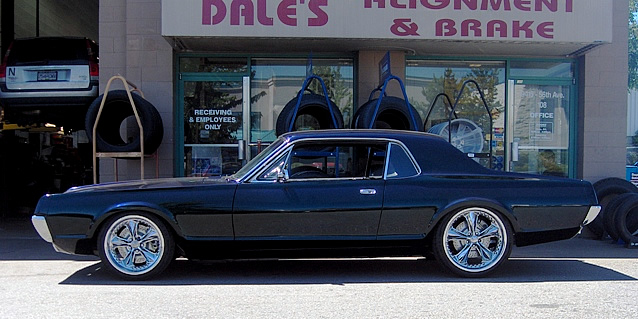
If the caster is different from
side to side, the vehicle will pull to the side with the less
positive caster. If the caster is equal but too negative, the
steering will be light and the vehicle will wander and be
difficult to keep in a straight line. If the caster is equal but
too positive, the steering will be heavy and the steering wheel
may kick when you hit a bump. Caster has little affect on tire
wear.
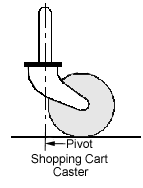 The
best way to visualize caster is to picture a shopping cart
caster. The pivot of this type of caster, while not at an angle,
intersects the ground ahead of the wheel contact patch. When the
wheel is behind the pivot at the point where it contacts the
ground, it is in positive caster. Picture yourself trying to
push the cart and keep the wheel ahead of the pivot. The wheel
will continually try to turn from straight ahead. The
best way to visualize caster is to picture a shopping cart
caster. The pivot of this type of caster, while not at an angle,
intersects the ground ahead of the wheel contact patch. When the
wheel is behind the pivot at the point where it contacts the
ground, it is in positive caster. Picture yourself trying to
push the cart and keep the wheel ahead of the pivot. The wheel
will continually try to turn from straight ahead.
That is what happens when a car has the caster set too far
negative. Like camber, on many front-wheel-drive vehicles,
caster is not adjustable. If the caster is out on these cars, it
indicates that something is worn or bent, possibly from an
accident, and must be repaired or replaced.
Toe-in
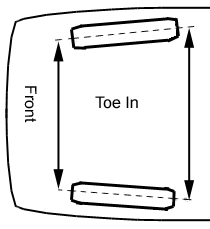 The
toe measurement is the difference in the distance between the
front of the tires and the back of the tires. It is measured in
fractions of an inch in the US and is usually set close to zero
which means that the wheels are parallel with each other. Toe-in
means that the fronts of the tires are closer to each other than
the rears. Toe-out is just the opposite. An incorrect toe-in
will cause rapid tire wear to both tires equally. This type of
tire wear is called a saw-tooth wear pattern as shown in this
illustration. The
toe measurement is the difference in the distance between the
front of the tires and the back of the tires. It is measured in
fractions of an inch in the US and is usually set close to zero
which means that the wheels are parallel with each other. Toe-in
means that the fronts of the tires are closer to each other than
the rears. Toe-out is just the opposite. An incorrect toe-in
will cause rapid tire wear to both tires equally. This type of
tire wear is called a saw-tooth wear pattern as shown in this
illustration.
If the sharp edges
of the tread sections are pointing to the center of the car,
then there is too much toe-in. If they are pointed to the
outside of the car then there is too much toe-out. Toe is always
adjustable on the front wheels and on some cars, is also
adjustable for the rear wheels.


Four Wheel Alignments
There are two main
types of 4-wheel alignments. In each case, the technician will
place an instrument on all four wheels. In the first type the
rear toe and tracking is checked, but all adjustments are made
at the front wheels. This is done on vehicles that do not have
adjustments on the rear. The second type is a full 4-wheel
alignment where the adjustments are first made to true up the
rear alignment, then the front is adjusted. A full 4-wheel
alignment will cost more than the other type because there is
more work involved.
|
|
Dales
Alignment & Brake Service Ltd.
108-19415-56th.
Ave.
Surrey, B.C. - Langley,
B.C.
V3S
6K2
Phone:
604-530-9160
Fax:
604-530-9168
|
|